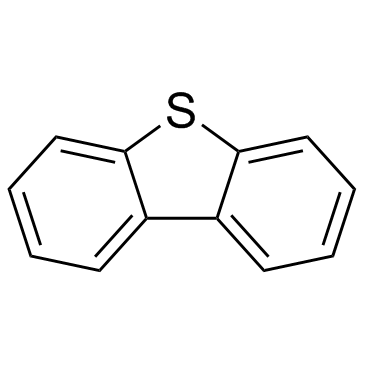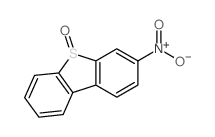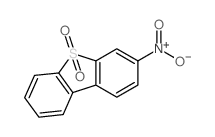132-65-0
| Name | dibenzothiophene |
|---|---|
| Synonyms |
9-Thiafluorene
Dibenzo(b,d)thiophene MFCD00004969 Diphenylene Sulfide a-thiafluorene 2,2'-Biphenylylene sulfide Diphenylenesulfide [1,1'-Biphenyl]-2,2'-diyl sulfide EINECS 205-072-9 Dibenzothiophene DBT,Diphenylene sulfide dibenzo[b,d]thiophene |
| Description | Dibenzothiophene is an intermediate of organic synthesis, consisting of two benzene rings fused to a central thiophene ring. |
|---|---|
| Related Catalog |
| Density | 1.3±0.1 g/cm3 |
|---|---|
| Boiling Point | 332-333 ºC |
| Melting Point | 97-100 °C(lit.) |
| Molecular Formula | C12H8S |
| Molecular Weight | 184.257 |
| Flash Point | 170 ºC |
| Exact Mass | 184.034668 |
| PSA | 28.24000 |
| LogP | 4.38 |
| Vapour Pressure | 0.0±0.7 mmHg at 25°C |
| Index of Refraction | 1.756 |
| Water Solubility | SOLUBLE |
Synonym:2,2'-Biphenylylene sulfide; 9-Thiafluorene; Dibenzo(b,d)thiophene; Diphenylene sulfide Section 2 - COMPOSITION, INFORMATION ON INGREDIENTS
Risk Phrases: 22 Section 3 - HAZARDS IDENTIFICATION EMERGENCY OVERVIEW
Harmful if swallowed. Potential Health Effects Eye: May cause eye irritation. Skin: May cause skin irritation. Ingestion: Harmful if swallowed. Causes gastrointestinal irritation with nausea, vomiting and diarrhea. Inhalation: May cause respiratory tract irritation. Chronic: Chronic ingestion may cause liver damage. Section 4 - FIRST AID MEASURES Eyes: In case of contact, immediately flush eyes with plenty of water for at least 15 minutes. Get medical aid. Skin: In case of contact, flush skin with plenty of water. Remove contaminated clothing and shoes. Get medical aid if irritation develops and persists. Wash clothing before reuse. Ingestion: If swallowed, do not induce vomiting unless directed to do so by medical personnel. Never give anything by mouth to an unconscious person. Get medical aid. Inhalation: If inhaled, remove to fresh air. If not breathing, give artificial respiration. If breathing is difficult, give oxygen. Get medical aid. Notes to Physician: Section 5 - FIRE FIGHTING MEASURES General Information: As in any fire, wear a self-contained breathing apparatus in pressure-demand, MSHA/NIOSH (approved or equivalent), and full protective gear. During a fire, irritating and highly toxic gases may be generated by thermal decomposition or combustion. This material in sufficient quantity and reduced particle size is capable of creating a dust explosion. Extinguishing Media: Use water spray, dry chemical, carbon dioxide, or chemical foam. Section 6 - ACCIDENTAL RELEASE MEASURES General Information: Use proper personal protective equipment as indicated in Section 8. Spills/Leaks: Vacuum or sweep up material and place into a suitable disposal container. Avoid generating dusty conditions. Provide ventilation. Section 7 - HANDLING and STORAGE Handling: Wash thoroughly after handling. Remove contaminated clothing and wash before reuse. Use with adequate ventilation. Minimize dust generation and accumulation. Avoid contact with eyes, skin, and clothing. Avoid breathing dust. Storage: Store in a cool, dry place. Store in a tightly closed container. Section 8 - EXPOSURE CONTROLS, PERSONAL PROTECTION Engineering Controls: Facilities storing or utilizing this material should be equipped with an eyewash facility and a safety shower. Use adequate ventilation to keep airborne concentrations low. Exposure Limits CAS# 132-65-0: Personal Protective Equipment Eyes: Wear appropriate protective eyeglasses or chemical safety goggles as described by OSHA's eye and face protection regulations in 29 CFR 1910.133 or European Standard EN166. Skin: Wear appropriate gloves to prevent skin exposure. Clothing: Wear appropriate protective clothing to minimize contact with skin. Respirators: Follow the OSHA respirator regulations found in 29 CFR 1910.134 or European Standard EN 149. Use a NIOSH/MSHA or European Standard EN 149 approved respirator if exposure limits are exceeded or if irritation or other symptoms are experienced. Section 9 - PHYSICAL AND CHEMICAL PROPERTIES Physical State: Crystalline powder Color: yellow to green Odor: Not available. pH: Not available. Vapor Pressure: Not available. Viscosity: Not available. Boiling Point: 332 - 333 deg C @ 760 mm Hg Freezing/Melting Point: 97 - 100 deg C Autoignition Temperature: > 450 deg C (> 842.00 deg F) Flash Point: 170 deg C ( 338.00 deg F) Explosion Limits, lower: Not available. Explosion Limits, upper: Not available. Decomposition Temperature: Solubility in water: soluble Specific Gravity/Density: Molecular Formula: C12H8S Molecular Weight: 184.26 Section 10 - STABILITY AND REACTIVITY Chemical Stability: Stable under normal temperatures and pressures. Conditions to Avoid: Dust generation. Incompatibilities with Other Materials: Strong oxidizing agents. Hazardous Decomposition Products: Carbon monoxide, oxides of sulfur, carbon dioxide. Hazardous Polymerization: Has not been reported. Section 11 - TOXICOLOGICAL INFORMATION RTECS#: CAS# 132-65-0: HQ3490550 LD50/LC50: CAS# 132-65-0: Oral, mouse: LD50 = 470 mg/kg. Carcinogenicity: Dibenzothiophene - Not listed by ACGIH, IARC, or NTP. Other: See actual entry in RTECS for complete information. Section 12 - ECOLOGICAL INFORMATION Section 13 - DISPOSAL CONSIDERATIONS Dispose of in a manner consistent with federal, state, and local regulations. Section 14 - TRANSPORT INFORMATION IATA Not regulated as a hazardous material. IMO Not regulated as a hazardous material. RID/ADR Shipping Name: Not regulated. Hazard Class: UN Number: Packing group: Section 15 - REGULATORY INFORMATION European/International Regulations European Labeling in Accordance with EC Directives Hazard Symbols: XN Risk Phrases: R 22 Harmful if swallowed. Safety Phrases: WGK (Water Danger/Protection) CAS# 132-65-0: No information available. Canada CAS# 132-65-0 is listed on Canada's DSL List. CAS# 132-65-0 is not listed on Canada's Ingredient Disclosure List. US FEDERAL TSCA CAS# 132-65-0 is listed on the TSCA inventory. SECTION 16 - ADDITIONAL INFORMATION N/A |
CHEMICAL IDENTIFICATION
HEALTH HAZARD DATAACUTE TOXICITY DATA
|
| Symbol |


GHS07, GHS09 |
|---|---|
| Signal Word | Warning |
| Hazard Statements | H302-H410 |
| Precautionary Statements | P273-P501 |
| Personal Protective Equipment | dust mask type N95 (US);Eyeshields;Faceshields;Gloves |
| Hazard Codes | Xn:Harmful; |
| Risk Phrases | R22 |
| Safety Phrases | S36 |
| RIDADR | 2811 |
| WGK Germany | 3 |
| RTECS | HQ3490550 |
| Packaging Group | III |
| Hazard Class | 9 |
| HS Code | 29349990 |
| Precursor 0 | |
|---|---|
| DownStream 2 | |
| HS Code | 2934999090 |
|---|---|
| Summary | 2934999090. other heterocyclic compounds. VAT:17.0%. Tax rebate rate:13.0%. . MFN tariff:6.5%. General tariff:20.0% |




